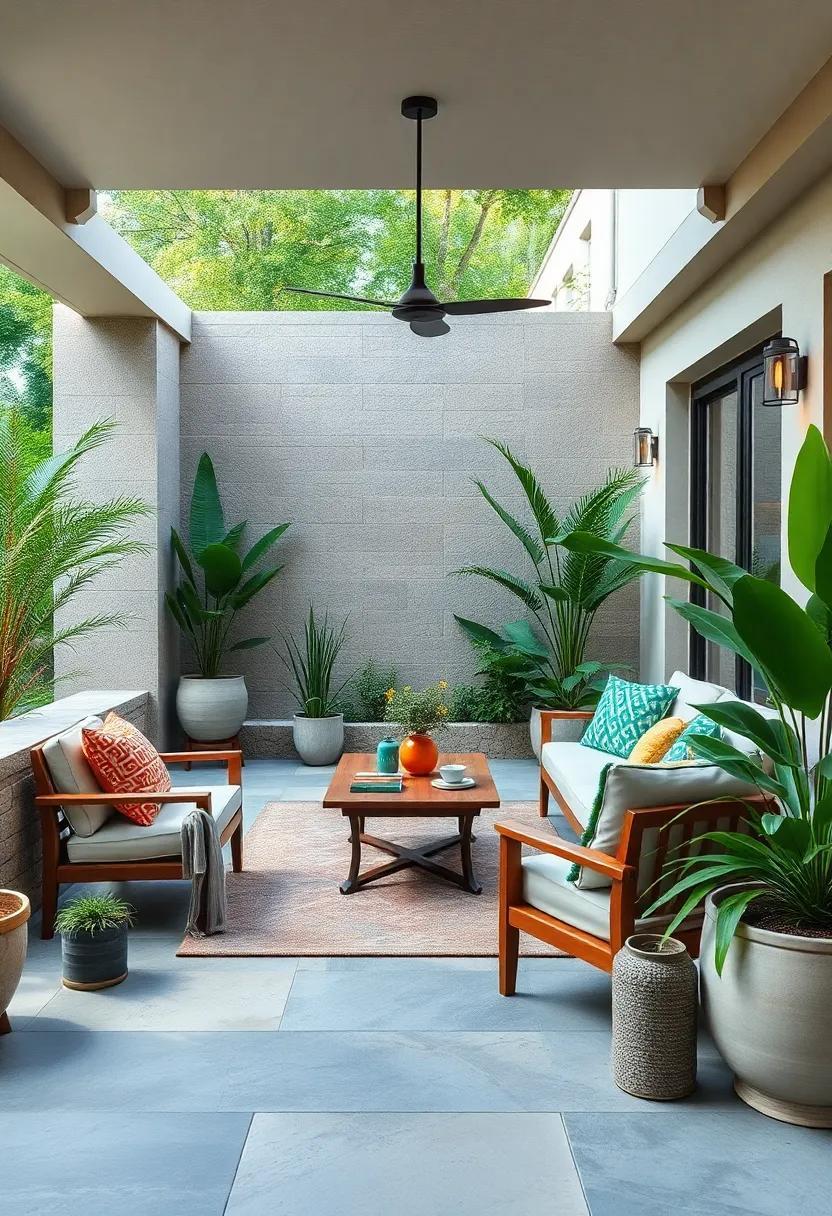
Green Spaces: Inspiring Eco-Friendly Patio Ideas for Sustainable Homeowners
In an age where environmental consciousness is more critical than ever, our outdoor spaces have transcended mere aesthetics, transforming into vital components of sustainable living.Green spaces are no longer just patches of grass or ornamental gardens; they are reflections of our commitment to eco-pleasant practices and our desire for harmony with nature. For homeowners seeking to create a nurturing haven right outside their doors, the patio serves as an amazing canvas for innovation and sustainability. in this article, we will explore a variety of creative and inspiring eco-friendly patio ideas that not only enhance outdoor beauty but also promote a greener lifestyle. From sustainable materials to innovative gardening techniques, let’s embark on a journey that celebrates the intersection of design and sustainability, turning our patios into vibrant ecosystems that thrive in harmony with the environment.
Natural Serenity in Urban Settings Embracing Green Patios That Connect with Nature
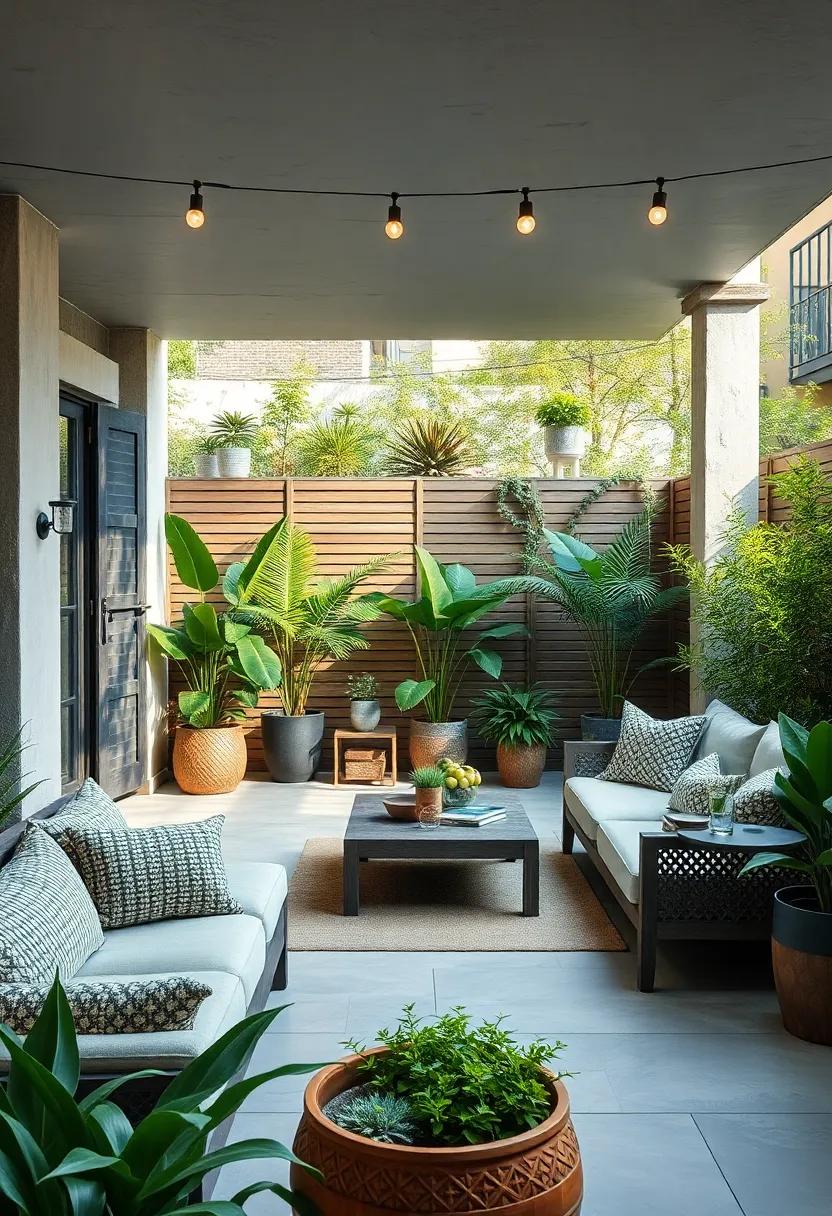
Urban living often means sacrificing green space, but with thoughtful design, it is possible to create vibrant patios that inspire tranquility. by incorporating elements that mimic nature, such as potted trees, vertical gardens, and natural materials, patios can transform into serene retreats. Adding features like water elements, such as a small fountain or a bird bath, can invite the soothing sounds of water, enhancing your connection with the environment. Consider using sustainable materials like reclaimed wood or bamboo for furniture, blending functionality with an eco-friendly ethos.
When it comes to greenery, a variety of plants can be strategically placed to create a lush atmosphere without overwhelming the space. Here are some ideas to incorporate:
- Herb Garden: Utilize small containers for herbs such as basil, thyme, and rosemary for culinary enjoyment and fragrant air.
- Succulents: Ideal for low-maintenance green spaces, these resilient plants add an artistic touch while requiring minimal care.
- Pollinator Plants: Choose flowers like lavender and bee balm to attract butterflies and bees, supporting local ecosystems.
Moreover, integrating sustainable lighting options can illuminate your patio beautifully while minimizing your carbon footprint. Solar-powered lanterns and LED lights can create an enchanting evening ambiance without relying on conventional electricity. By designing outdoor spaces that prioritize nature and sustainability, urban dwellers can forge a meaningful connection with the environment right outside their doors.
Creative Plant Arrangements Bringing Color and Life to Small Balcony Spaces
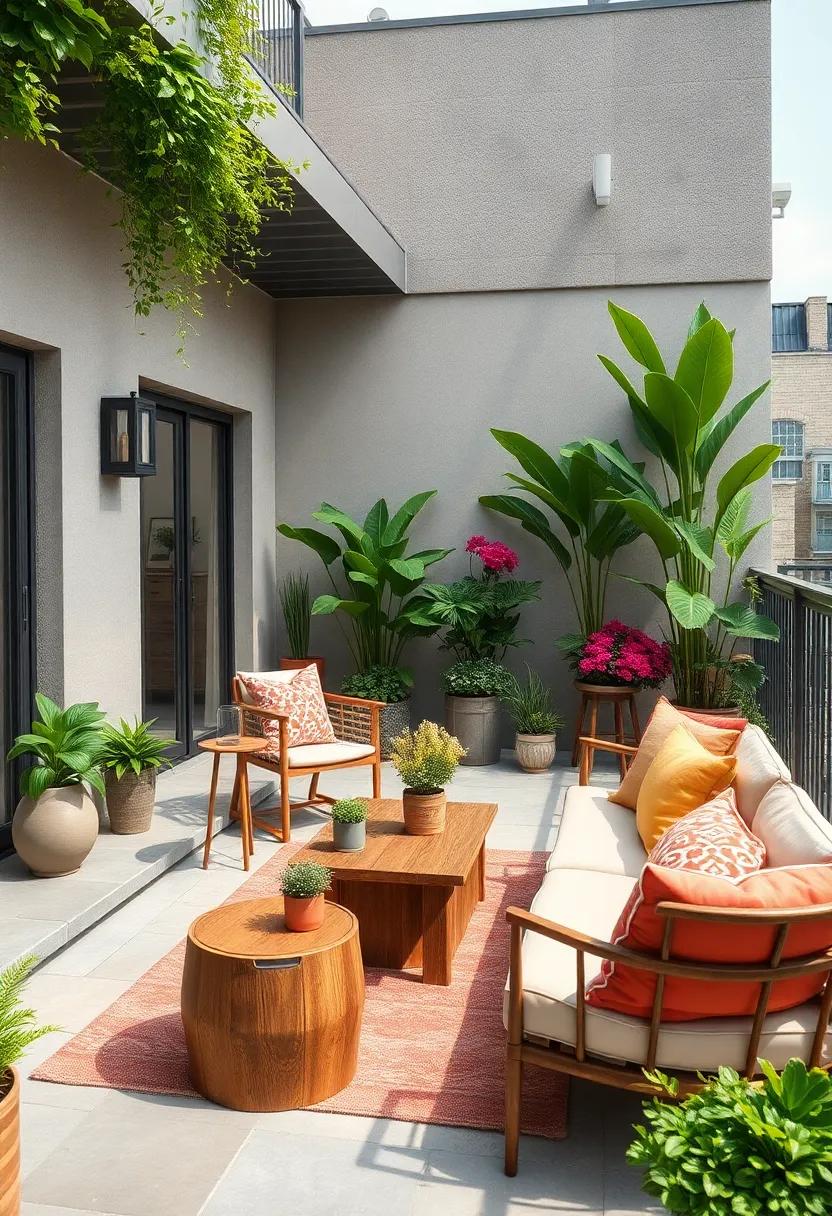
Transforming a small balcony into a vibrant oasis doesn’t require an extensive garden; it simply needs a touch of creativity and a splash of color.consider elevating your space with hanging planters that allow cascading greenery to drape gracefully over the edges. pair these with vertical gardens that can be mounted against walls, utilizing every inch of available space and creating a powerful focal point. Choose from a variety of drought-resistant plants like succulents or colorful flowers that thrive in compact environments, ensuring that your balcony is both stunning and eco-conscious.
| Plant Type | Color | water Needs |
|---|---|---|
| Succulents | Variety (greens, pinks) | Low |
| Petunias | Vibrant Purple, Pink | Moderate |
| Ferns | Bright Green | High |
don’t forget to incorporate decorative pots and recycled containers to create a unique styling element. Mixing and matching colors and textures in pots can enhance the charm of your mini-garden. Use string lights to add a whimsical touch, providing both functionality and a cozy atmosphere after sunset. If your balcony is sparse on sunlight, consider using grow lights for your plants to flourish, creating that striking pop of life that energizes your space and draws you outdoors.
Sustainable Furniture Choices Eco-Friendly Seating Solutions for Outdoor Relaxation
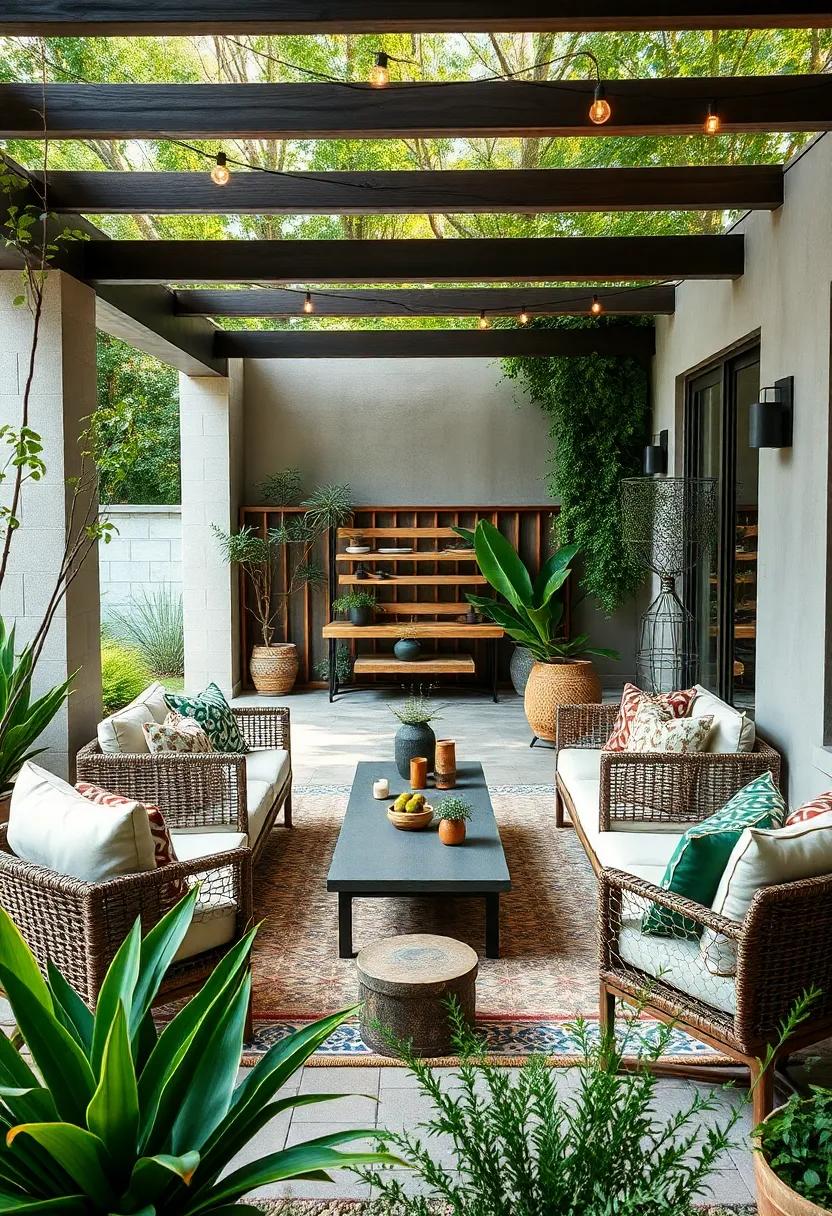
When it comes to enhancing your outdoor spaces, choosing eco-friendly seating solutions can significantly impact both your environment and your comfort. Recycled materials are increasingly becoming the material of choice for outdoor furniture, providing durability while reducing waste.Consider options like:
- Reclaimed wood benches: These are not only stylish but also help in minimizing deforestation.
- Bamboo chairs: Fast-growing and sustainable, bamboo offers a chic, lightweight alternative.
- Aluminum lounge chairs: Frequently enough made from recycled content, they are rust-resistant and recyclable themselves.
- Eco-friendly cushions: Look for those filled with organic materials and wrapped in sustainable fabrics.
Select your outdoor seating with care to create a space that harmonizes with nature. Check out our handy table below that outlines some of the most popular sustainable materials and their eco-friendly benefits:
| Material | Benefits |
|---|---|
| Reclaimed Wood | Reduces wood waste and adds rustic charm. |
| Bamboo | Fast-growing, regenerates quickly, and is biodegradable. |
| Recycled Plastic | Durable, whether-resistant, and diverts plastic from landfills. |
| Hemp Fabric | Strong,sustainable,and requires less water to grow. |
By prioritizing these materials for your outdoor seating, you not only contribute to a healthier planet but also set a precedent for sustainable living that inspires others.
Vertical Gardens Transforming Walls into Lush Green Backdrops for Patios
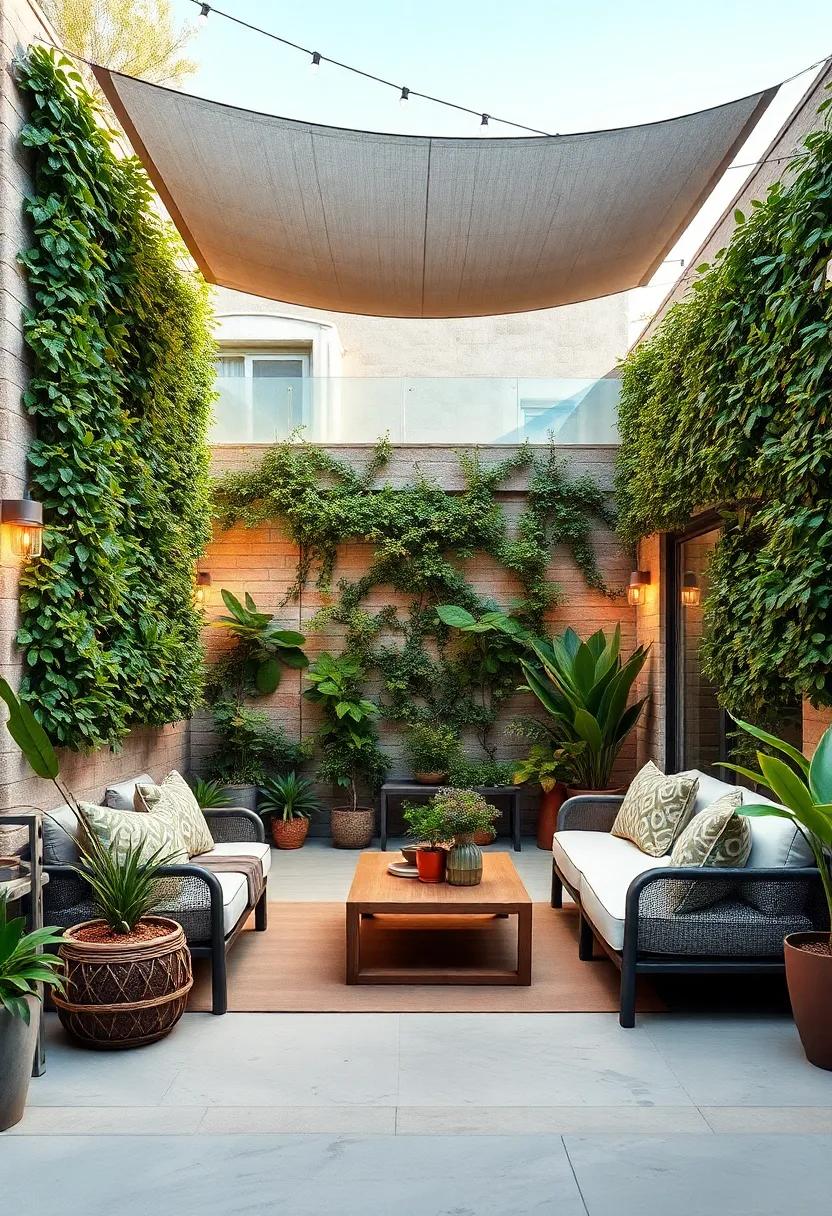
Imagine walking out onto your patio and being enveloped in a vibrant oasis, where walls come alive with vertical gardens that breathe new life into your outdoor space. These living wall systems not only beautify but also contribute significantly to environmental sustainability by improving air quality and reducing noise pollution. The various plants used in these installations—from cascading ferns to colorful flowering vines—work harmoniously to create a stunning backdrop that changes with the seasons, offering a fresh perspective year-round.
To successfully incorporate a vertical garden in your patio setup, consider the following elements:
- Plant Selection: Choose plants that thrive in your climate and suit your aesthetic preferences, such as succulents for a modern look or herbs for a functional garden.
- Structural Support: Ensure you have a sturdy framework, whether through prefabricated panels or custom-built structures, to support your vertical garden.
- Watering System: Implement a drip irrigation system for easy maintenance and to keep your plants lush without overwatering.
When designed thoughtfully, these living installations become the focal point of your patio, inspiring not just relaxation but also conversation and connection with nature.By adding layers of greenery to the vertical space, homeowners can redefine their outdoor experience, turning mundane walls into flourishing canvases of life.
Recycled Materials in Design Inspiring Sustainable Choices for charming Outdoor Decor

Incorporating recycled materials into outdoor design not only champions sustainability but also adds a unique charm to patios and gardens. By reimagining discarded goods, homeowners can create visually appealing spaces that tell a story while being kind to the planet. Consider the following ideas to enhance your outdoor decor:
- Upcycled Furniture: Transform old pallets into rustic tables or chairs, giving them a new life while preserving their character.
- Repurposed Planters: Use tin cans,wooden crates,or even bathtubs to house your plants,striking a balance between eco-friendliness and artistic expression.
- Reclaimed Wood Features: Build a charming trellis or bench from reclaimed wood, adding warmth and an organic feel to your space.
Moreover, integrating these materials fosters creativity and encourages mindfulness about consumption. Homeowners can cultivate a whimsical environment while taking purposeful steps toward environmental stewardship. To further inspire sustainable choices, explore how various recycled items can transform your patio:
| Recycled Material | Potential Use |
|---|---|
| Glass Jars | Hanging lanterns or garden lighting |
| Old Tires | Planters or seating solutions |
| Corrugated metal | Gabions or decorative borders |
Edible Gardens Cultivating Fresh Herbs and Vegetables in Your Outdoor Oasis
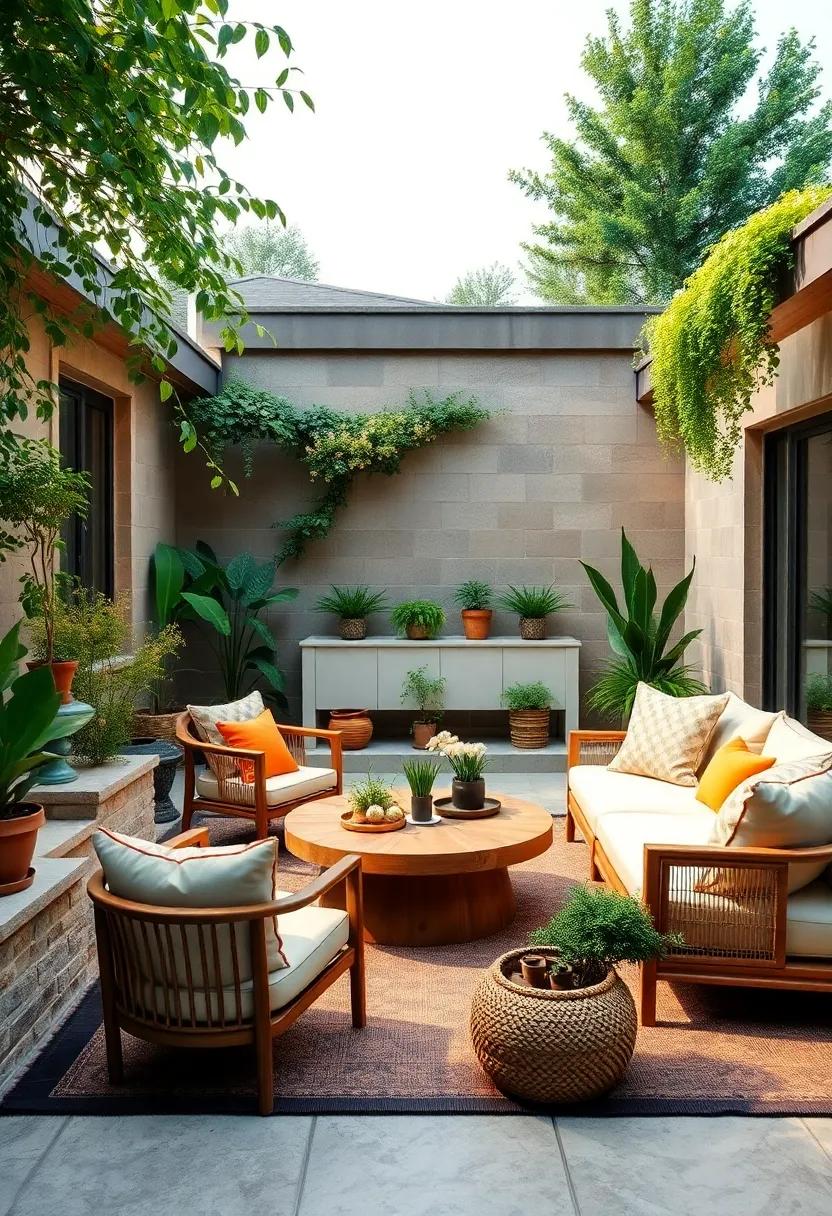
Transform your outdoor oasis into a bountiful edible garden, where fresh herbs and vegetables thrive amidst lush greenery.Planning your garden can be both an art and a science, as you decide on the perfect layout and plants to cultivate. Consider incorporating these staple herbs to enhance your culinary adventures:
- Basil: A summer favorite, perfect for pesto and salads.
- Mint: Refreshing in drinks and desserts, and great for pest control.
- Thyme: Versatile, adding depth to various dishes.
- Parsley: A nutritional powerhouse, ideal for garnishing and flavoring.
- Chives: Mild onion flavor, perfect for salads and soups.
Choose a sunny corner of your patio or backyard where these herbs can bask in sunlight. Pair your herbs with easy-to-grow vegetables like tomatoes, peppers, and lettuce to create a sustainable garden that nourishes both body and spirit. To maximize your space, consider vertical gardening techniques or container gardening options, which allow for a neat and organized aesthetic. Explore the following table showcasing some vegetables ideal for small spaces:
| Vegetable | Space Requirement | Harvest Time |
|---|---|---|
| Cherry Tomatoes | 2 square feet | 60-70 days |
| Radishes | 1 square foot | 30 days |
| Salad Greens | 1 square foot | 30-60 days |
| Peppers | 2 square feet | 70-90 days |
Wildlife Friendly Spaces Creating Inviting habitats for Birds and Beneficial Insects

Transforming your patio into a sanctuary for wildlife not only benefits local ecosystems but also enhances your outdoor experience. Incorporate native plants that provide nectar, pollen, and shelter for birds and beneficial insects.Consider the following options for your greenery:
- Flowering Plants: Choose species like coneflowers, bee balm, and lavender that attract pollinators.
- Fruit-bearing Shrubs: Plant berry bushes such as blueberries and elderberries to feed both birds and beneficial insects.
- Nesting Areas: Install birdhouses or leave small brush piles for small mammals and beneficial insects to find shelter.
Additionally, adding water features can significantly enhance the appeal of your green space. Birds and beneficial insects are drawn to shallow birdbaths or small ponds, which also create a dynamic habitat for life to thrive.Consider setting up a small water station in your patio design. Here’s a simple table summarizing key features to include:
| Feature | Description | Benefits |
|---|---|---|
| Native Plants | Local flora that thrives with minimal care | Supports biodiversity and attracts wildlife |
| Water Source | Shallow birdbaths or pond | Provides hydration for birds and beneficial insects |
| Nesting Materials | Brush or small piles of leaves | Offers homes for wildlife |
Water Features Enhancing Patios with Eco-Conscious Fountains and Ponds
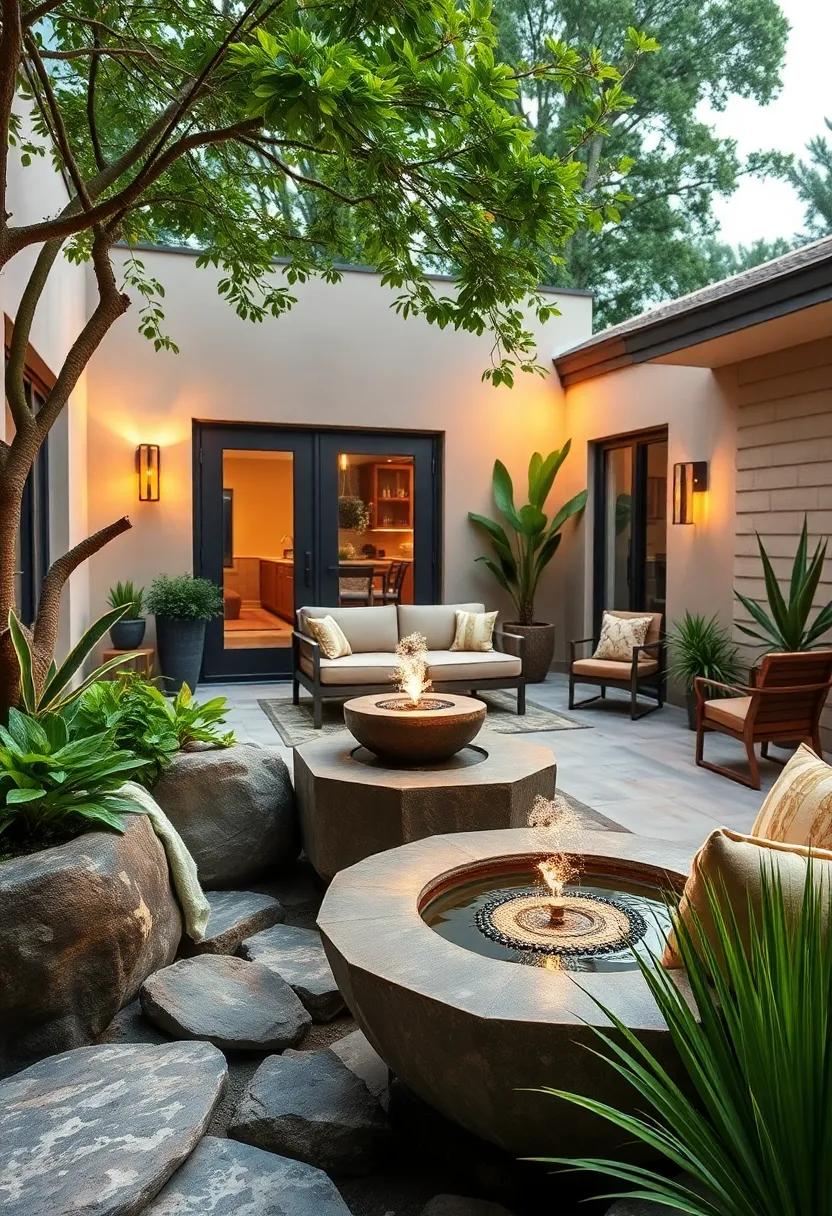
Incorporating fountains and ponds into your patio design not only adds a stunning visual element but also provides a multitude of environmental benefits. Eco-conscious fountains can be designed to use recycled water, minimizing the impact on local water sources. Consider using solar-powered pumps to circulate water in your fountain, reducing electricity consumption while harnessing the power of the sun. Adding aquatic plants like water lilies or lotuses not only enhances the aesthetic but also contributes to the local ecosystem by supporting wildlife and improving water quality.
Ponds can serve as a tranquil retreat, offering a habitat for frogs, butterflies, and birds, thus promoting biodiversity right in your backyard. To maximize the eco-friendliness of your pond,consider integrating native plants that require minimal maintenance and are drought-resistant. when designing these water features, focus on natural materials such as stone or reclaimed wood to keep the design harmonious with the environment. Here’s a fast look at some sustainable choices for your water features:
| Feature | Eco-Friendly Benefits |
|---|---|
| Solar-powered Fountains | Reduces energy usage and costs |
| Native Aquatic Plants | Supports local wildlife and biodiversity |
| Rainwater Harvesting Systems | Conserves water resources |
| Recycled Building Materials | Reduces waste and environmental footprint |
Seasonal Decorations Transitioning Your Patio Through the Seasons with Natural Elements
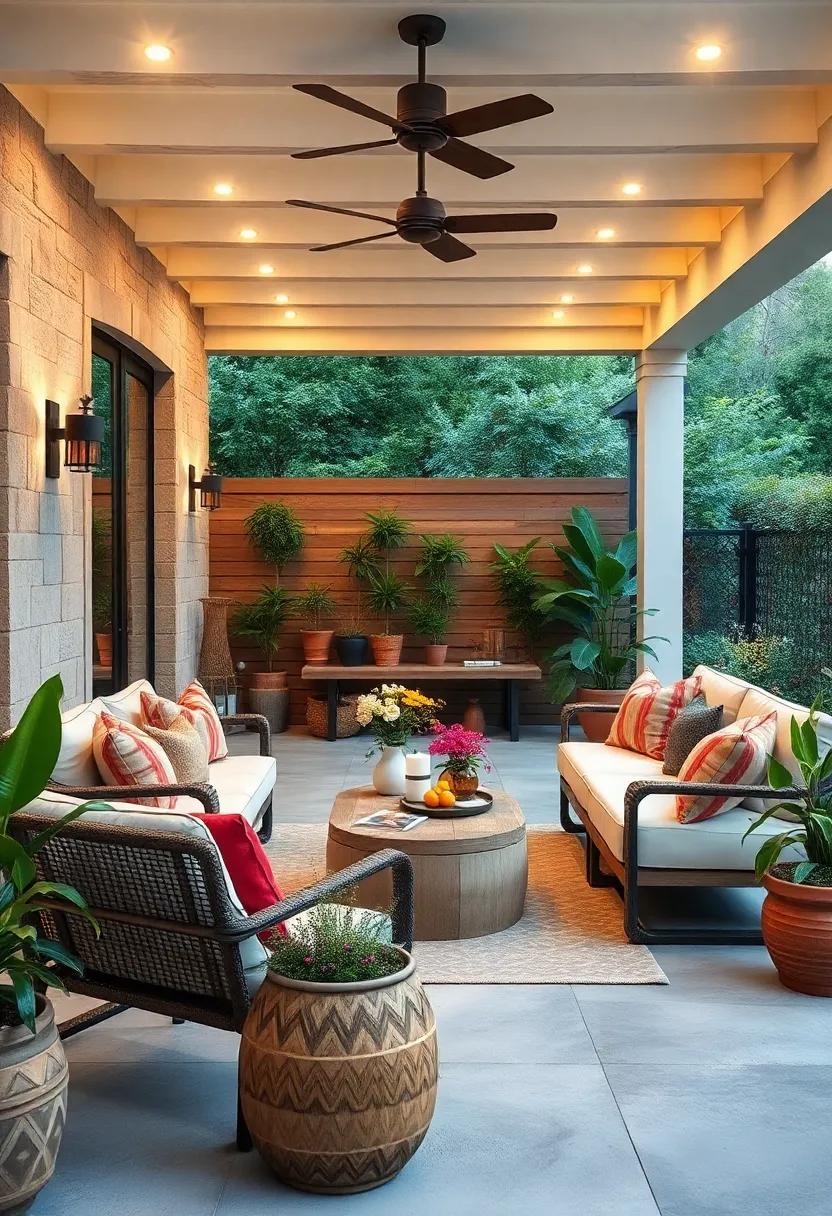
Transforming your patio into a seasonal haven can be a delightful endeavor, especially when incorporating natural elements that enhance both aesthetics and sustainability. In spring, consider an arrangement of vibrant potted plants and hanging flowers crafted from reclaimed materials. Choose perennial herbs such as thyme, rosemary, and basil that not only flourish with minimal maintenance but also spice up your kitchen dishes. For a touch of whimsy, add recycled glass wind chimes to gently dance in the breeze, creating a symphony of natural sounds that summon the joy of the season.
As summer rolls in, shift your décor to embrace shades of lush greens and vibrant blooms. Use natural fibers like jute or cotton for throws and cushions, ensuring comfort while maintaining an eco-friendly approach. For a striking centerpiece, opt for a wooden table hewn from sustainably sourced timber, adorned with a table runner made of upcycled fabric. Come autumn, swap out your vibrant décor for warm, earthy tones.Fill your space with decorative gourds and pumpkins, displaying them in metal or wooden containers, which can be repurposed for winter décor. To further your commitment to sustainability, consider a mini compost bin for leftover plant materials, ensuring your patio remains a lush, thriving environment year-round.
Solar Lighting Options Illuminating Your Outdoor Space with Eco-Friendly Solutions

Mindful Outdoor Spaces Designing Patios for Relaxation and Mental Well-Being
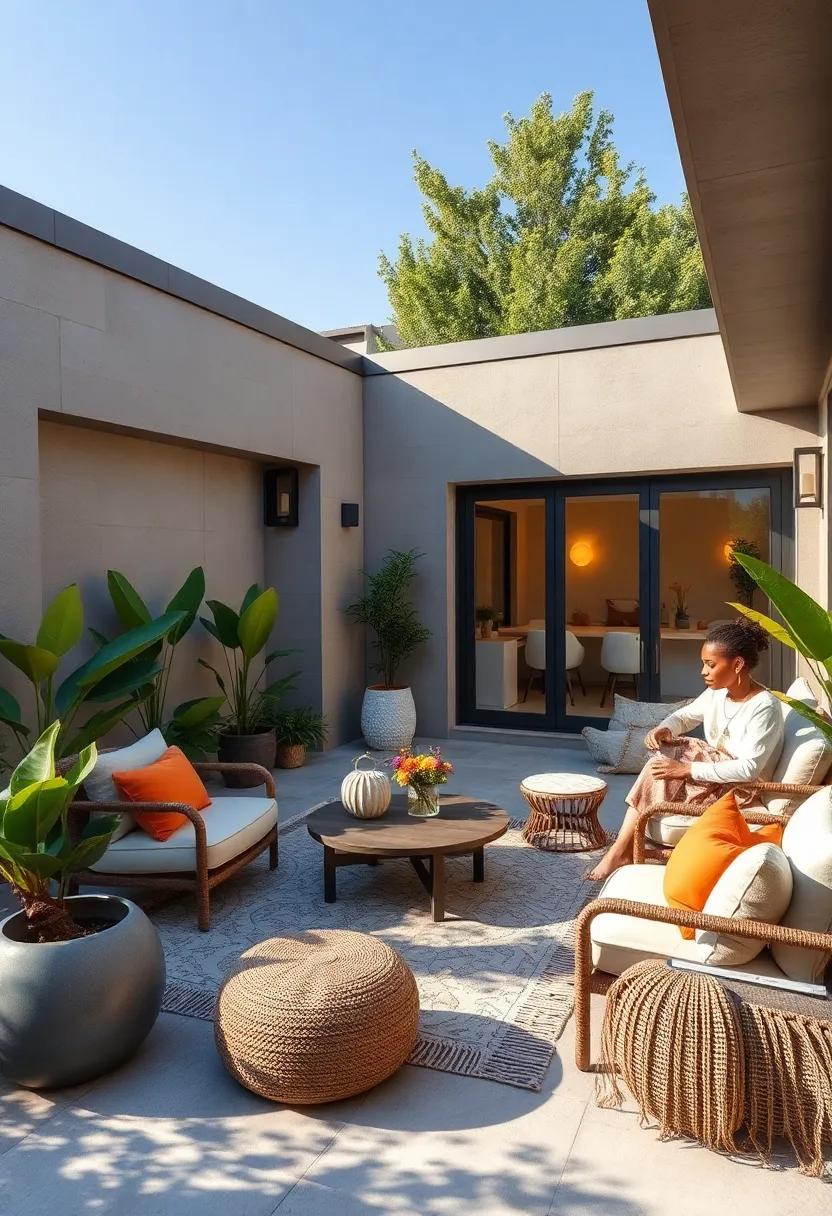
Designing outdoor spaces that promote relaxation and mental well-being is essential for creating a peaceful retreat at home. Incorporate natural elements to enhance tranquility and foster a connection with the environment.Think about integrating features like:
- Seating Areas – Use pleasant, weather-resistant furniture made from sustainable materials to invite you to unwind and enjoy your surroundings.
- Greenery – Plant native flora and incorporate vertical gardens or potted plants to enhance biodiversity while boosting air quality.
- Water features – Consider adding a small fountain or pond to create soothing soundscapes that can help lower stress levels.
- Soft Lighting – Install solar-powered lights to illuminate paths and create a relaxing atmosphere for evening gatherings.
To fully utilize the potential of your patio, layout is crucial. Use zoning techniques to create distinct areas for various activities like reading,meditating,or entertaining. A well-designed patio might include zones like:
| Zone | Description |
|---|---|
| Relaxation Corner | A cozy nook with cushions or a hammock, surrounded by plants for a serene reading environment. |
| Dining Area | A table with eco-friendly seating options, perfect for meals under the stars. |
| Meditation Space | A quiet area with natural stones and soft mats,ideal for mindfulness practices. |
Color Palette Inspirations Harmonizing Nature with Chic Design for Your Patio
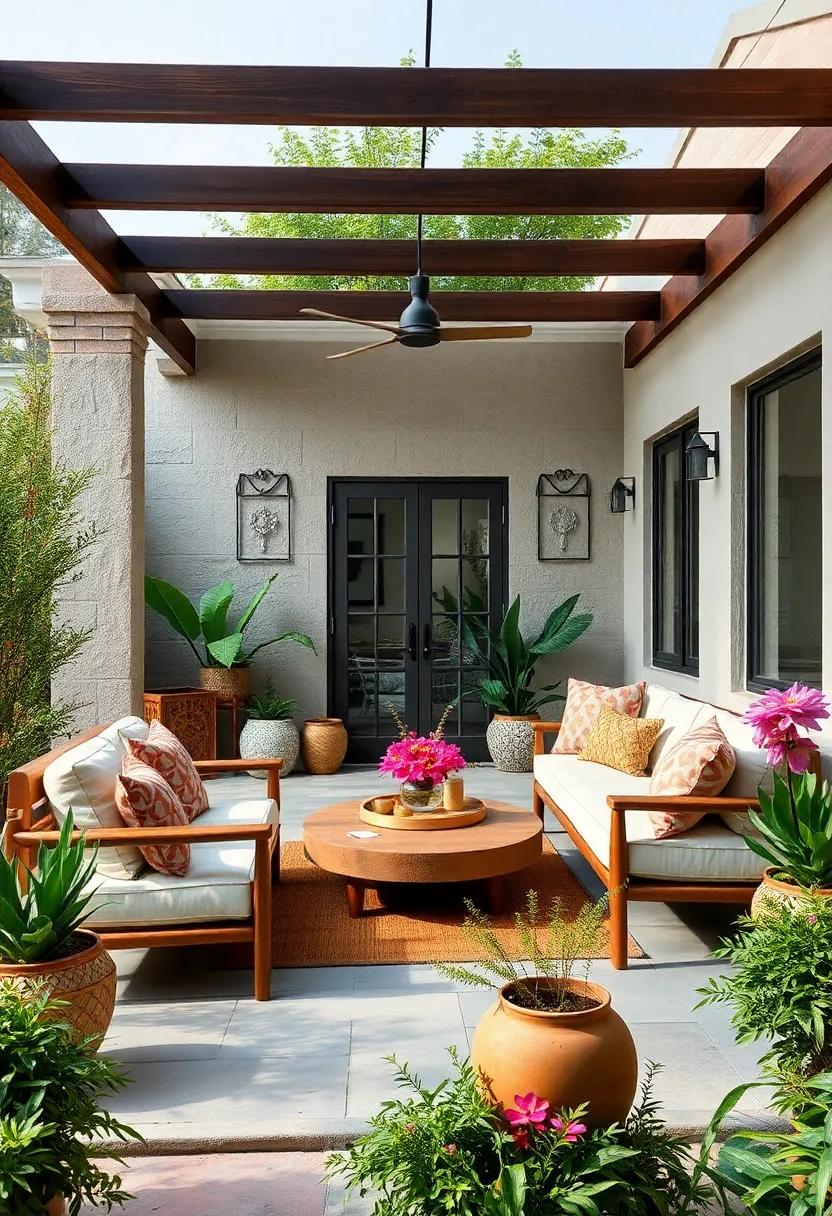
Transforming your patio into a space that reflects nature’s enchanting beauty can be effortlessly achieved with a thoughtfully curated color palette. By drawing inspiration from the great outdoors, you can combine shades that not only enhance your surroundings but also evoke a sense of tranquility and casual elegance. Consider utilizing earthy greens, inspired by lush foliage, alongside soft browns reminiscent of natural wood tones. Accents of sky blue can mimic clear skies, while hints of warm terracotta can ground your space with a touch of rustic charm.
To achieve a harmonious design, explore the following combinations that beautifully blend chic aesthetics with natural hues:
- Serene Greens and Crisp Whites: Ideal for a fresh and airy look.
- Muted Blues and Sandy Beiges: Creates a calming coastal vibe.
- Warm Terracotta with Olive Greens: Perfect for a cozy and inviting atmosphere.
- Charcoal Grays paired with Leafy Greens: Adds a modern twist while honoring natural elements.
| Color Combination | Emotion Evoked |
|---|---|
| serene Greens and Crisp Whites | freshness and Vitality |
| Muted Blues and Sandy Beiges | Calmness and Relaxation |
| Warm Terracotta with Olive Greens | Cozy and Inviting |
| Charcoal Grays paired with Leafy Greens | Modern and Sophisticated |
Interactive Kids’ Gardens Encouraging Play and Learning in Eco-Friendly Outdoor Spaces
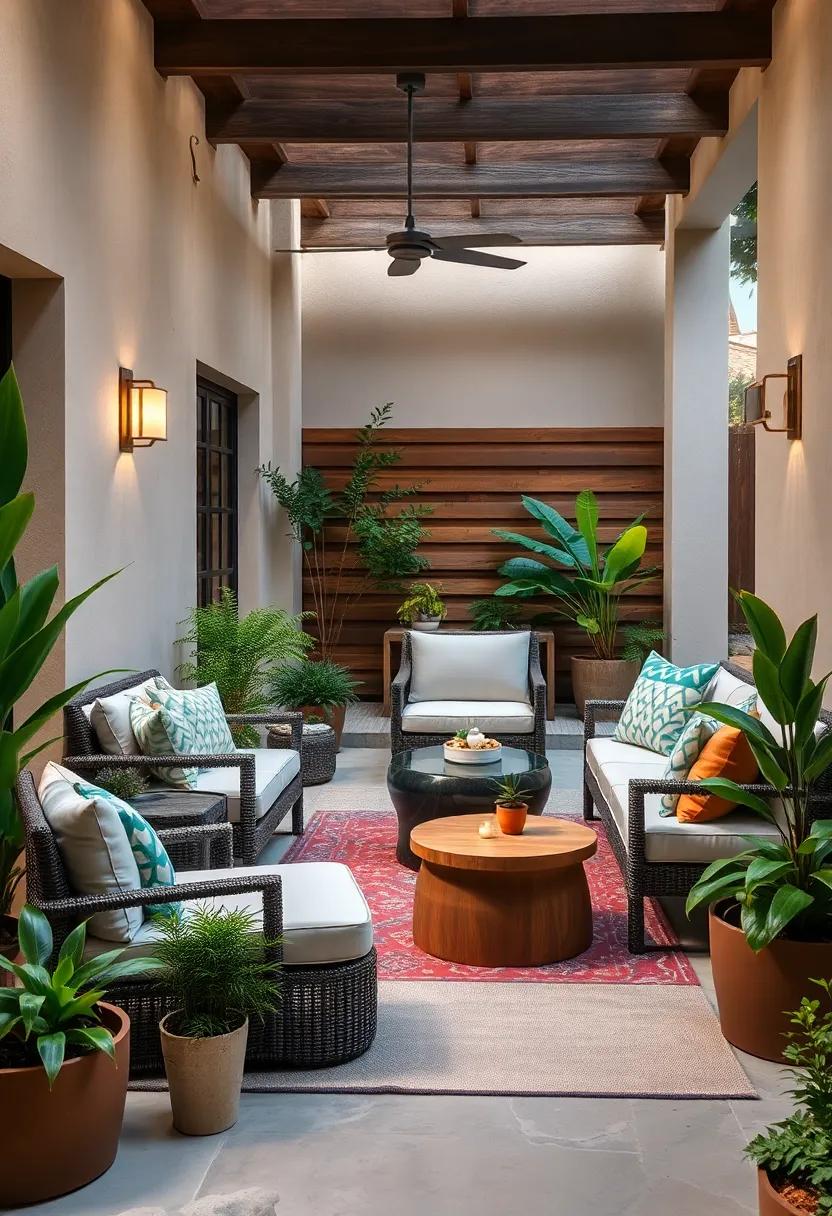
Creating a vibrant outdoor space that engages children can be as simple as incorporating interactive elements into your garden.Think about adding features that not only beautify the area but also promote play and foster learning. Some ideas include:
- Rainwater Collection Systems: Install barrels that allow kids to observe rainwater harvesting while understanding the importance of water conservation.
- Vertical Gardens: Encourage vertical gardening with easy-to-maintain plants that children can care for, teaching them responsibility and the basics of plant biology.
- Interactive Storytelling Corners: Construct small seating areas with themed decorations where kids can gather for story time, igniting their imaginations amidst nature.
- Garden Pathways: Utilize natural materials to create pathways that lead to secret spots, stimulating adventure as children explore their surroundings.
Incorporating sensory elements into garden designs can significantly enhance children’s engagement. By integrating textures, sounds, and scents, you create an immersive experience that piques curiosity. Consider the following sensory installations:
- Fragrant Plants: Use herbs and flowering plants that emit delightful scents, enticing children to explore with their noses.
- Wind Chimes and Water features: Introduce gentle sounds from natural elements that enrich the auditory experience, making outdoor play more enchanting.
- Tactile Exploration Zones: Designate areas with different textured materials for tactile exploration, helping children connect with nature through touch.
- Colorful Flower Beds: Plant flowers of various colors to stimulate visual senses, fostering recognition for flowers and the environment.
Patio Planning for Pollinators Attracting Bees and Butterflies with Thoughtful Planting
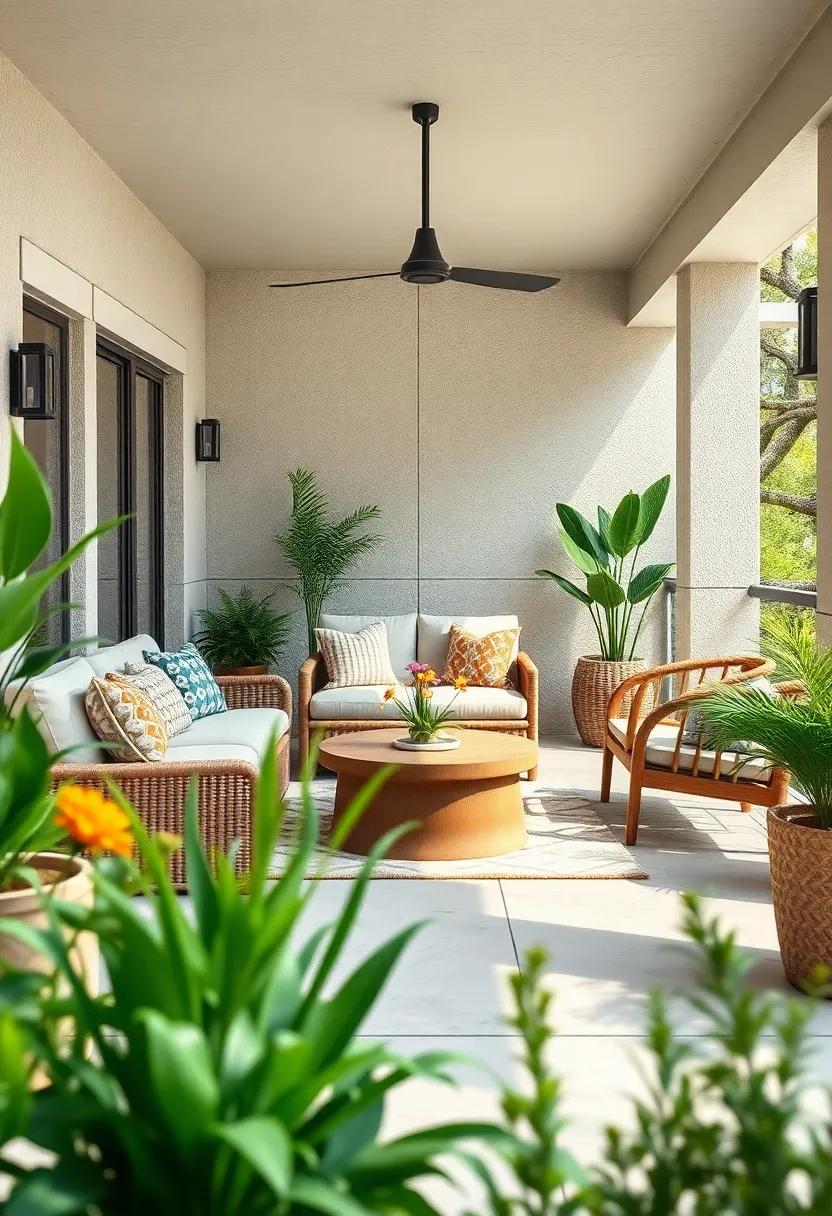
Creating a vibrant patio that welcomes pollinators like bees and butterflies can transform your outdoor space into a lively sanctuary. Focus on incorporating a variety of native flowering plants that bloom at different times throughout the season to provide a continuous supply of nectar and pollen. Some fantastic options include:
- Milkweed: Essential for monarch butterflies.
- Echinacea (Coneflower): Attracts a variety of pollinators and adds vibrant color.
- Lavender: A favorite for both bees and human visitors for its soothing scent.
- Sedum: A drought-tolerant choice that thrives in sunny spots.
Incorporating these plants into your patio design not only beautifies your space but also contributes to local ecosystems. Consider structuring your garden with layers to create an inviting habitat. Use a simple layout like this to maximize both aesthetics and functionality:
| plant Type | Blooming Time | Height |
|---|---|---|
| Milkweed | Summer | 3-4 feet |
| Echinacea | Summer-Fall | 2-4 feet |
| Lavender | Summer | 1-3 feet |
| Sedum | Late Summer | 1-2 feet |
Position taller plants towards the back of your patio garden, gradually decreasing in height towards the front to ensure all plants receive adequate sunlight while creating an engaging visual layer. Adding flowering herbs like thyme, basil, and rosemary not only enhances your patio’s aesthetic but also functions as a tasty addition for both culinary delights and beneficial insects. Design your space with pollinator-friendly features, such as shallow water dishes and stone pathways to encourage visits from these delightful creatures while promoting a sustainable environment.
Nature-Inspired Textures Using Natural Materials to Create Warm and Inviting Patios
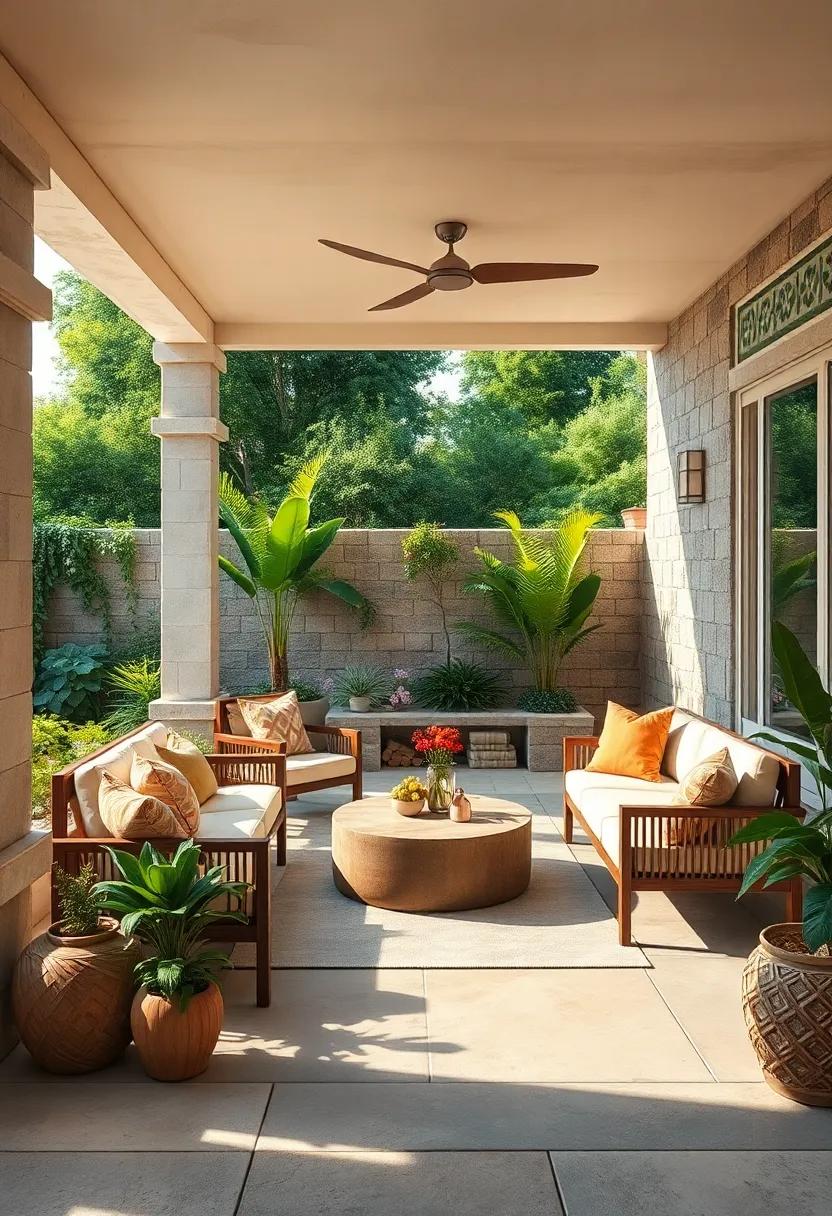
Embrace the beauty of nature by incorporating natural materials that echo the grandeur of the outdoors into your patio design. Use wood, stone, and clay to create stunning textures that resonate with the surrounding environment. Consider installing a deck made from sustainably sourced timber or laying down flagstone crisscrossed with moss, inviting a soft green touch. Bamboo, with its aesthetic appeal and sustainability, can serve as a chic fencing option that adds warmth while providing privacy. incorporating aggregate concrete with embedded pebbles can evoke the feel of walking along a riverbank, creating a tactile journey for your guests.
To enhance the overall ambiance, introduce elements such as ceramic pots and woven baskets, organically linking your patio to the natural world. These materials not only provide texture but also serve as versatile décor solutions. Groupings of natural fiber rugs can define spaces and add comfort, encouraging outdoor lounging. Consider adding a wooden pergola adorned with climbing plants, which not only brings vertical interest but also casts enchanting shadows during sunny afternoons. Together, these elements forge an inviting sanctuary that celebrates eco-friendliness and fosters a sense of tranquility.
Sustainable Fabric Selections Choosing eco-Friendly Textiles for Outdoor Comfort
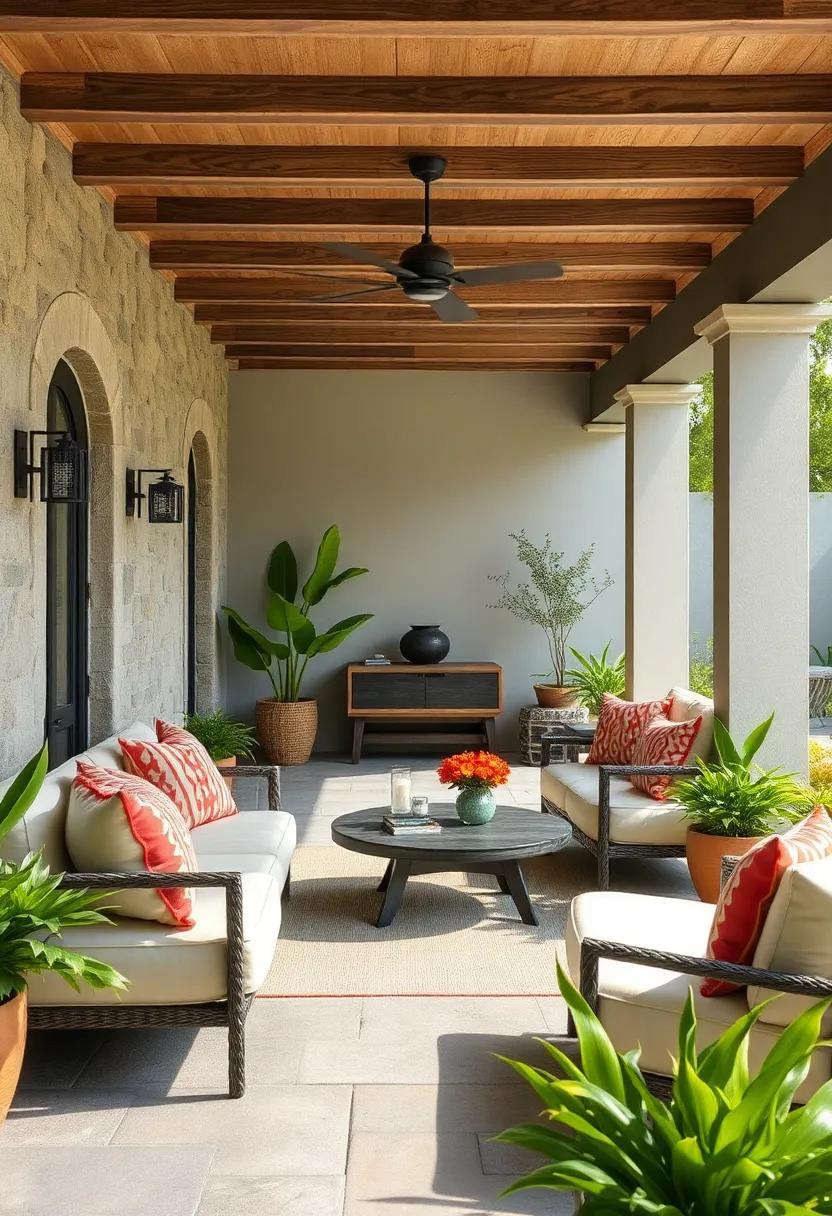
When designing an outdoor living space, the choice of textiles can significantly influence both comfort and sustainability. Opting for eco-friendly materials means you are contributing to a healthier planet while enhancing your patio’s aesthetic. Start by considering fabrics made from organic cotton, bamboo, or hemp, which are not only biodegradable but also require fewer chemicals during production. These materials provide excellent breathability, and moisture-wicking properties, making them ideal for outdoor settings. Additionally, look for textiles that are dyed with natural pigments to avoid harmful chemicals and ensure vibrant hues that harmonize with nature.
To further embrace sustainability, pay attention to the durability of the chosen fabrics. Recycled textiles, like recycled polyester derived from plastic bottles, offer a robust solution for outdoor upholstery, standing up to the elements while reducing waste.For added comfort, consider layering your outdoor seating with eco-friendly cushions. Here’s a simple guide to help you in selecting the best eco-friendly fabric options:
| Fabric Type | Properties | Sustainability |
|---|---|---|
| Organic Cotton | Soft, breathable | Grown without pesticides |
| Bamboo | Moisture-wicking, antibacterial | Fast-growing, requires less water |
| Hemp | Durable, UV-resistant | Low environmental impact |
| Recycled Polyester | Fade-resistant, weatherproof | reduces plastic waste |
Community Gardens Fostering Connection Through Shared Green Spaces and Gardening
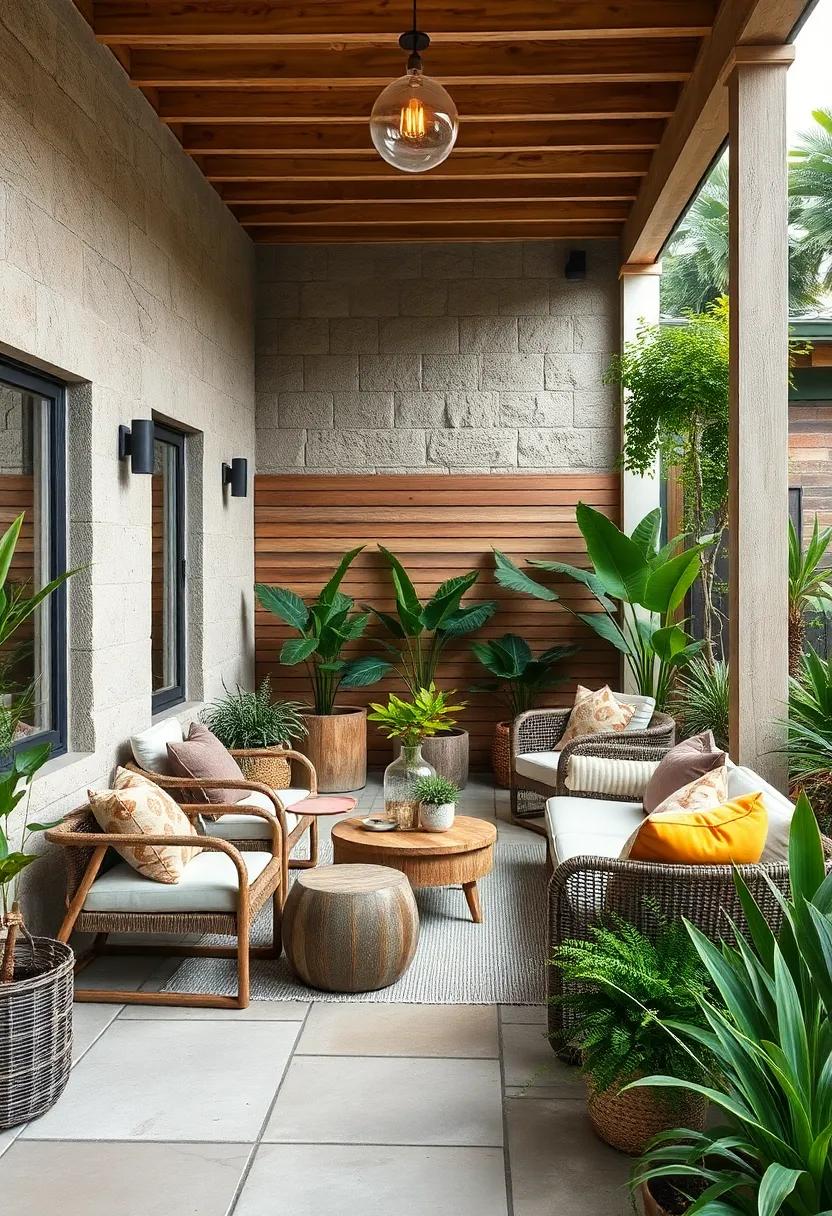
Community gardens act as living tapestries woven from the threads of diverse backgrounds and experiences. They transform vacant lots into lush spaces where neighbors come together, sharing not just soil but knowledge and stories. By participating in gardening activities, individuals bond over the joys of planting, nurturing, and harvesting.The benefits also extend beyond mere aesthetics, as these green spaces contribute significantly to local biodiversity and promote sustainable practices. engaging with nature helps alleviate stress and fosters a sense of belonging, turning ordinary spaces into vibrant hubs of life.
A garden is not merely a place to grow food; it is indeed a communal experience and a tool for education. Many gardens organize workshops that cover an array of topics such as organic gardening, composting, and water conservation. These initiatives encourage eco-friendly practices, nurturing both the environment and the spirit of the community. Here’s how these gardens contribute to sustainability:
| Aspect | Benefit |
|---|---|
| Local Food Production | Reduces carbon footprint from transportation. |
| Pollinator-Friendly Plants | Enhances local biodiversity and supports ecosystems. |
| Community Engagement | Strengthens social ties and promotes sharing of resources. |
| Environmental Education | Inspires sustainability awareness among participants. |
Rainwater Harvesting Techniques Innovative Ways to Capture Water for Sustainable Plant Care
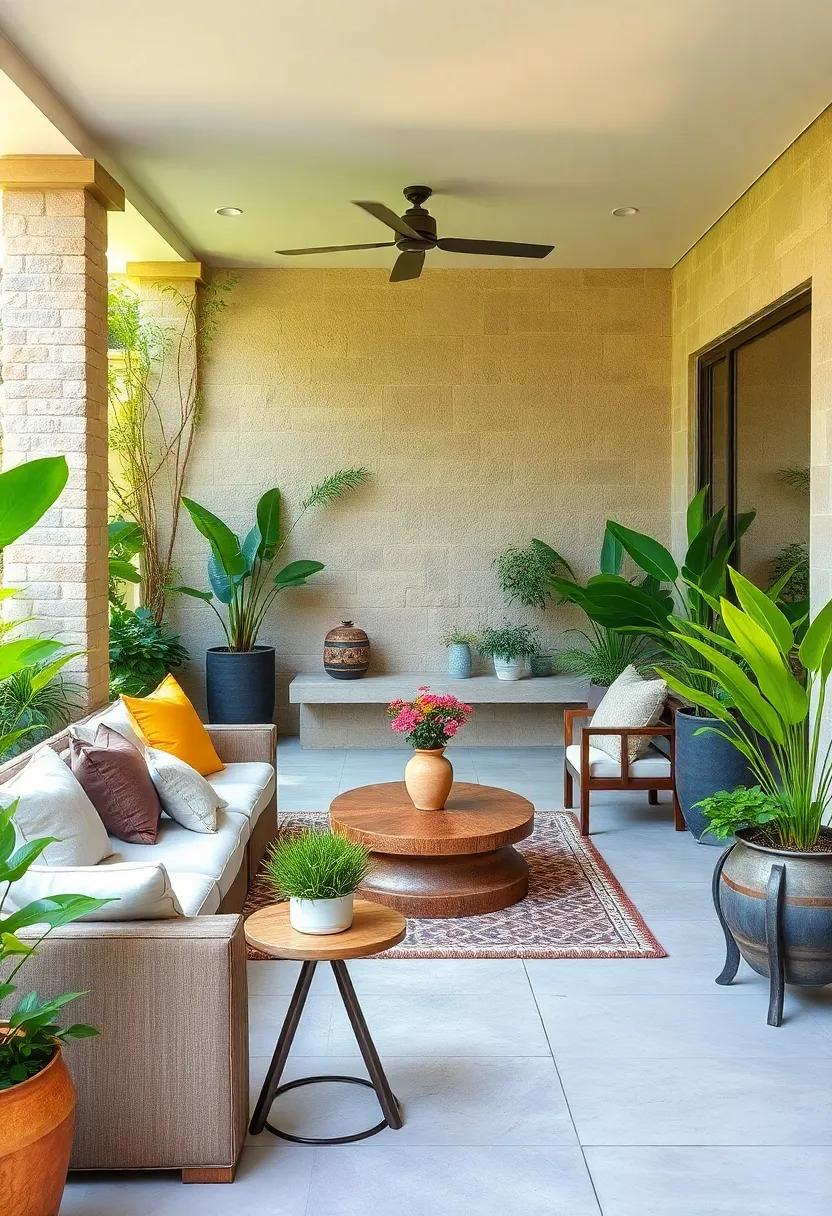
Incorporating effective rainwater harvesting techniques can significantly enhance sustainable plant care on your patio.One innovative method is to install rain barrels, which are large containers that collect runoff from rooftops. by positioning barrels strategically under your downspouts, you can gather water during episodes of rain, providing a natural irrigation resource. Additionally, consider creating a rain garden, an aesthetically pleasing and functional landscape feature that utilizes native plants to absorb and filter rainwater.This not only nourishes your plants but also contributes to local biodiversity.
For those looking to maximize their water-capturing potential, permeable paving is another exciting option. This type of flooring allows rainwater to seep through and replenish groundwater, while also reducing surface runoff. Implementing drip irrigation systems connected to your rain barrels can ensure that each plant receives the right amount of water directly at the roots.employing simple features like water catchment awnings can further enhance your setup, directing rainwater efficiently while offering shade and comfort on hot summer days.
Historical Inspirations Designing Patios with a Nod to Nature in Architectural Heritage
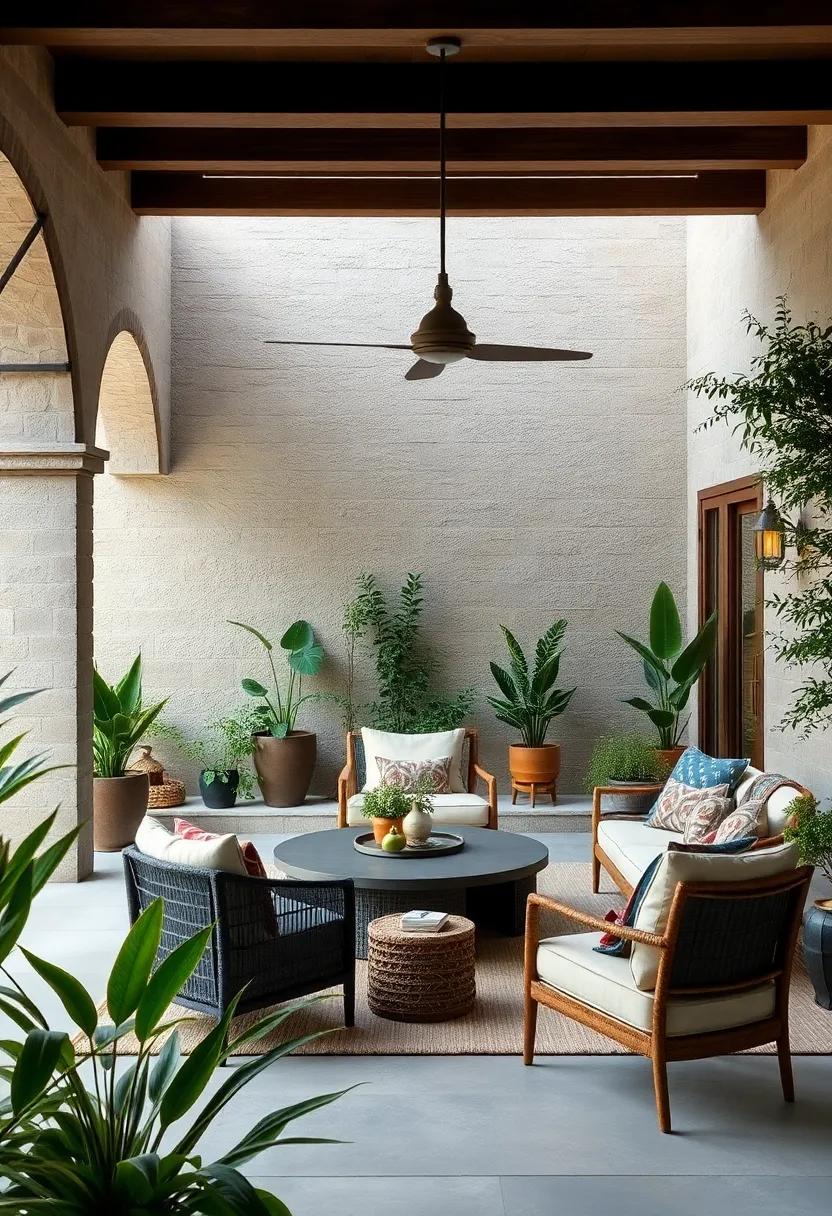
Throughout history, the design of outdoor spaces has often mirrored the natural environments surrounding them. From the elegant courtyards of ancient Rome, adorned with lush gardens and intricate mosaics, to the minimalist zen gardens of Japan, these designs were not merely for aesthetic pleasure but also served to foster a deeper connection between humanity and nature. By incorporating elements such as natural stone paths, native plants, and recycled materials, contemporary patios can echo these historical influences while promoting eco-friendly principles. Such designs allow homeowners to celebrate the locale’s unique biodiversity and heritage, creating spaces that are both beautiful and sustainable.
The blending of architectural styles also plays a role in producing cozy and welcoming outdoor environments. For example, Spanish-style patios feature vibrant tiles and terracotta pots, while Scandinavian designs embrace simplicity with their focus on functionality and the use of light woods and greenery. To imbue your patio with historical charm, consider the following features:
- Natural Materials: Use wood, stone, or clay that reflects the local landscape.
- Water Elements: Incorporate small ponds or fountains, reminiscent of ancient designs.
- Seating Arrangements: Create cozy nooks with recycled furnishings or handmade benches.
Mindful Materials Selecting Sustainably Sourced Elements for Outdoor Environments
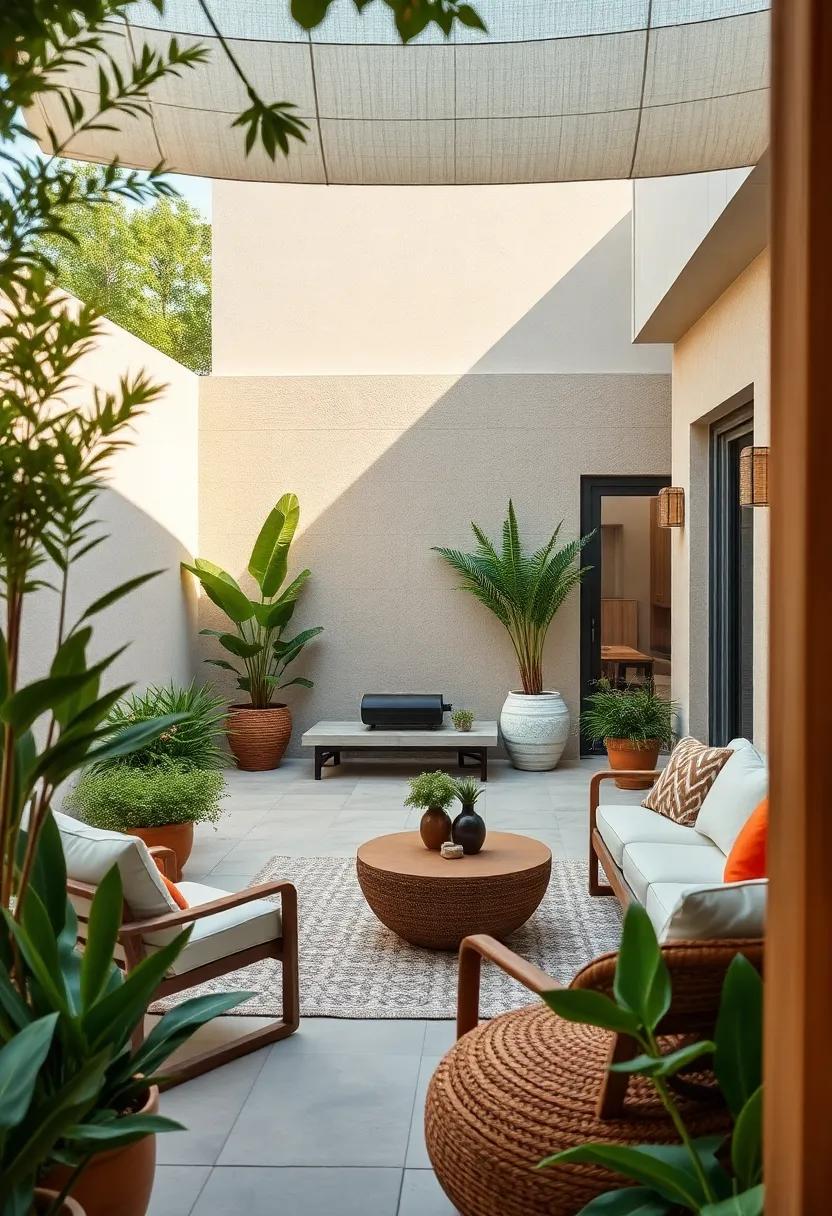
Transforming your outdoor spaces begins with choosing materials that honor the environment. When selecting elements for your patio,consider the longevity and sustainability of the materials. Opt for locally sourced wood, such as reclaimed or certified sustainable lumber, which reduces transportation emissions and supports local economies. For hardscapes, recycled concrete or natural stone can provide both durability and aesthetic appeal, seamlessly blending with the natural landscape. By prioritizing these options, you not only create a stunning outdoor oasis but also contribute to responsible resource management.
Incorporating native plants and organic furnishings made from eco-friendly materials, such as bamboo or biodegradable composites, enhances the sustainable character of your patio. Additionally,consider integrating elements that promote energy efficiency and water conservation. This can include:
- Rain gardens to manage runoff and nourish plants naturally
- Solar lighting for illumination without the carbon footprint
- Permeable paving to allow rainwater infiltration
By harmonizing these elements, your outdoor sanctuary will not only be a visual delight but also a model of environmental stewardship.
Container Gardening creativity Using Pots and Planters to Maximize Outdoor greenery
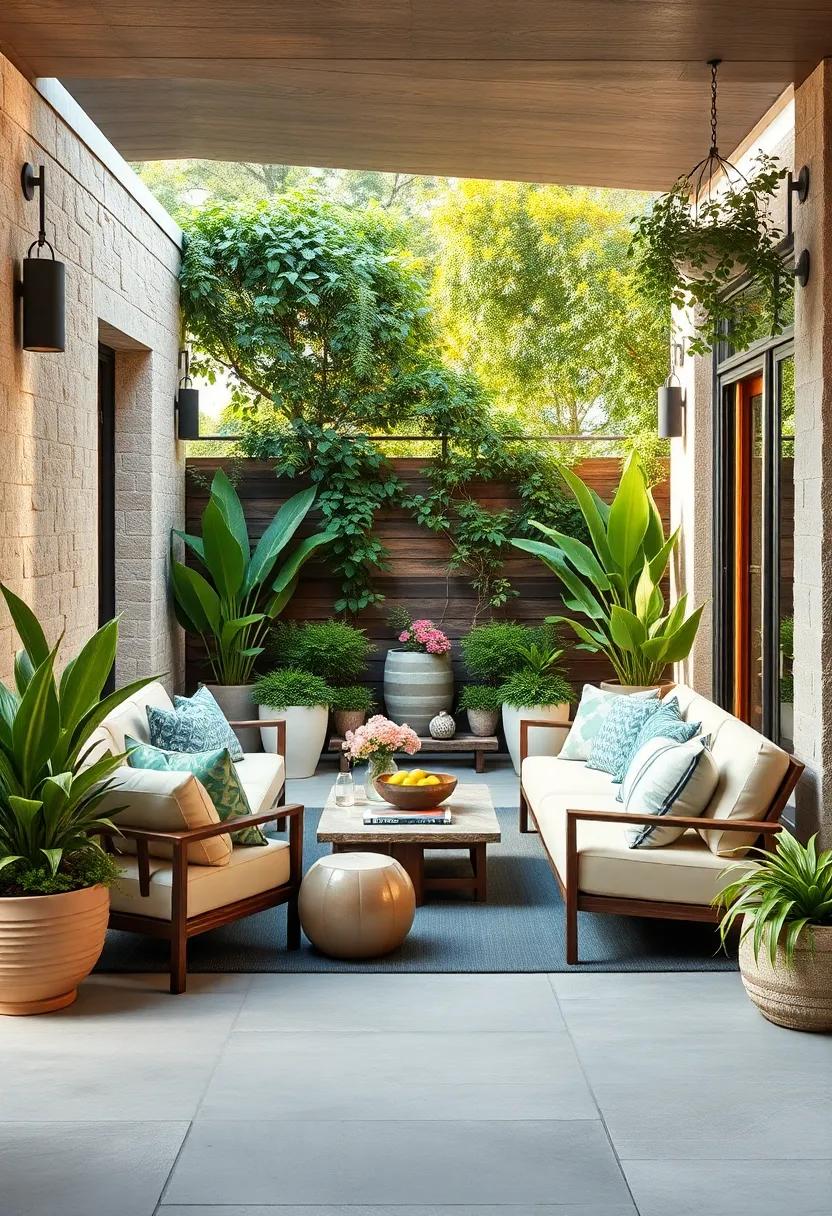
Embrace the art of container gardening by transforming pots and planters into vibrant expressions of nature. Not only do these versatile vessels allow you to maximize your outdoor space, but they also encourage creativity in your gardening approach. Consider a variety of materials and designs, from terracotta to recycled metal, to add texture and style. Layering colors and sizes enhances visual interest,so mix and match tall,short,wide,and narrow containers. Secrets of prosperous container gardening lie in selecting the right plants and arranging them thoughtfully. Here are some ideas to spark your imagination:
- Herb Haven: Use small pots for diverse herbs like basil,mint,and rosemary,creating a fragrant culinary corner.
- Vertical Gardens: Stack planters to utilize vertical space, perfect for flowering vines and succulents.
- Seasonal Themes: Rotate pot contents with seasonal flowers, ensuring your garden remains dynamic throughout the year.
In addition to aesthetics, sustainability can be woven into your container gardening. Implement self-watering systems using repurposed materials,such as plastic bottles or old kitchen sinks transformed into planters. To maximize your impact,why not create a community planter? Invite neighbors to contribute plants and decor—fostering both connection and greenery. Below is a simple guide on choosing suitable plants based on your outdoor conditions:
| Condition | Best Plants |
|---|---|
| Full Sun | Tomatoes,Marigolds,Lavender |
| Partial Shade | Ferns,Begonias,hostas |
| Full Shade | Snake Plant,Peace Lily,Ivy |
Biodiverse Planting Strategies Selecting Varied Flora for Resilient and Beautiful Spaces

Incorporating a variety of plants into your patio design not only enhances aesthetic appeal but also promotes environmental health. By selecting an array of flora, you can create microhabitats that attract essential pollinators and beneficial insects.Consider these options for your eco-friendly patio:
- Natives: Choose native plants that are well-adapted to your local climate, requiring less water and maintenance.
- Perennials: include hardy perennials that can survive seasonal changes,providing year-round beauty.
- Edibles: Incorporate herbs and vegetables that can be harvested, adding functionality to your green space.
- Flowering Varieties: Select flowers that bloom at different times to create a colorful landscape throughout the seasons.
To ensure a resilient planting strategy, mixing plant types in layers can create a dynamic and visually captivating environment. Consider the following table, which highlights plants suitable for various patio conditions:
| Plant Type | Sunlight | Water Needs |
|---|---|---|
| Succulents | Full Sun | Low |
| ferns | Partial Shade | Moderate |
| Lavender | Full Sun | Low |
| Mint | Partial Shade | High |
Implementing these diverse planting strategies not only fosters a thriving ecosystem but also offers a sense of tranquility and beauty to your outdoor space.engaging with a selection of varied flora can transform your patio into a sustainable sanctuary, perfect for relaxing, entertaining, or simply enjoying the wonders of nature at home.
The Conclusion
As we draw the curtains on our exploration of Green Spaces, it’s clear that a sustainable patio is more than just a backyard addition; it’s a personal retreat, a vibrant ecosystem, and a conscious choice for the planet. By embracing eco-friendly materials, native plants, and innovative designs, homeowners can transform their outdoor oasis into a thriving sanctuary that harmonizes with nature.
Every plant nurtured, every sustainable material chosen, and every mindful design reflects a commitment not only to individual well-being but to the health of our planet. as you consider implementing these inspiring ideas, remember that each small step contributes to a larger movement toward environmental stewardship.
So, gather your tools, ignite your creativity, and embark on your journey to design a patio that is as green in spirit as it is indeed in aesthetics.In every detail, let your outdoor space tell a story of sustainability, inviting both relaxation and responsibility. After all, in the heart of every eco-friendly patio lies a promise: to cultivate beauty, preserve our earth, and inspire others to join the movement toward a greener tomorrow. Happy gardening!
As an Amazon Associate I earn from qualifying purchases.



